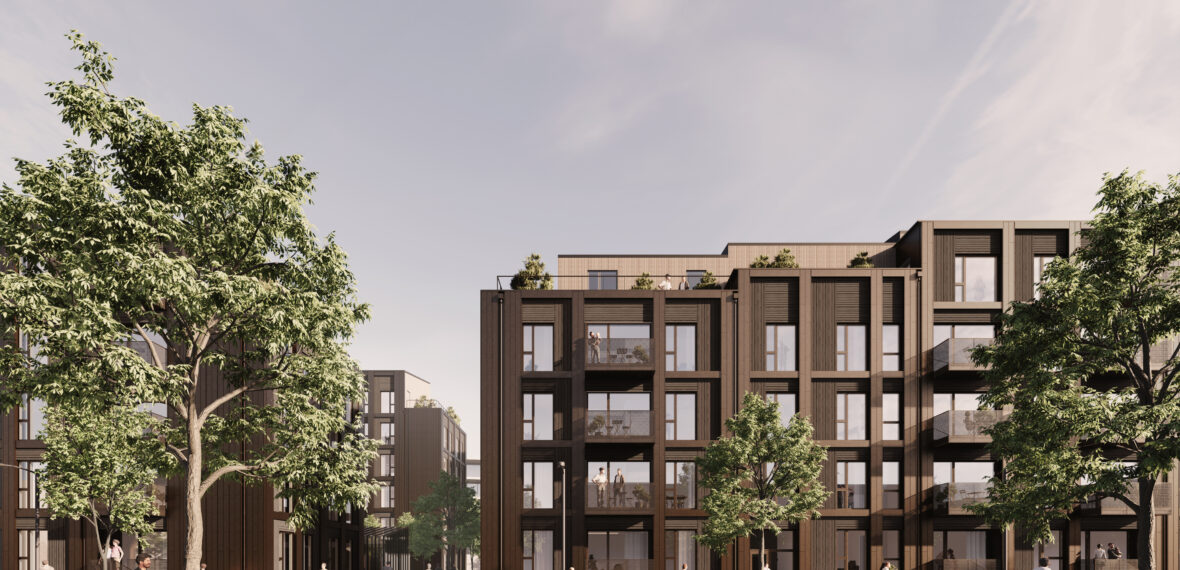Nrep to build timber residential building with unprecedented low carbon footprint

Leading Nordic real estate investor Nrep has announced the construction of a six-storey timber residential building in Nordhavn (North Harbour), Copenhagen’s new sustainable harbourside city district. The 13,100 sq m development will have the lowest ever carbon emissions for a building over four floors in Denmark due to its wooden construction.
Denmark has a long history of sustainable architecture and green construction practices. The country has just passed new legislation that further tightens the level of CO2 that is permitted to be emitted by new buildings, including during the construction phase. Denmark is the first country to introduce embodied carbon limits into building regulations. From 1 July 2025, multi-storey apartment buildings must have max emissions of 7.5 kg of CO2 per sq m and a max of 1.5 kg of CO2 per sq m for emissions arising from the construction phase.
Designed by Henning Larsen, the building be comprised of 115 apartments and two commercial spaces and is expected to be ready for occupancy by mid-2026. The Nordhavn development from Nrep will have a total of 5kg of CO2 per sq m which is well below the new strict, requirement.
To celebrate the start of construction, a groundbreaking ceremony took place yesterday with special guests, the Danish Minister for Social Affairs and Housing, Pernille Rosenkrantz-Theil and Copenhagen’s Lord Mayor Sophie Hæstorp Andersen. Former Lord Mayor of Copenhagen and current Director of Urban Planning at Nrep, Jens Kramer Mikkelsen hosted the event.
To reduce CO2 emissions, there has been close collaboration with leading, progressive suppliers, including architects from Henning Larsen, the contractor 5E, and Søren Jensen Consulting Engineers. This has led to most elements traditionally made of concrete being replaced with timber materials. This includes load-bearing structures, walls, and partially facades, but also smaller elements such as shower stalls, elevator shafts, and stair cores.
Additionally, there will be a focus on ensuring that transport during the construction phase with electric vehicles as much as possible, and the construction will take place under a total covering. This is to prevent the wood from getting moist and ensuring both a healthier construction and a lower CO2 emission during the build.
During its lifespan, the timber construction will bind a large amount of CO2, which will be released again at the theoretical burning of the materials after 50 years. There is an emphasis on designing the building so that it can easily be disassembled and recycled if the construction one day needs to be demolished. The building will also be nearly self-sufficient in energy thanks to ground spikes, a heat pump, and solar panels.
Nicole van der Star, Investment Developer at Nrep, said: “The new timber construction builds on the many experiences within CO2 reduction that we have from other projects, including the UN17 Village in Ørestad. We are now using this knowledge to create an even stronger CO2 profile. The project will be an open source project, and we will share both blue print and construction plans so that others can freely copy or be inspired by the project.”
The new multi-story building will be based on construction traditions that the industry is familiar with and can therefore easily be scaled. Troels Dam Madsen, Associate Design Director at the world-renowned Danish architectural firm, Henning Larsen has played a key role and has considered design, functionality, and sustainability in every detail.
Troels Dam Madsen, Associate Design Director at Henning Larsen, said: “Architecture is about creating and rethinking buildings in a way that is both unique and forward-looking. Architects are faced with inventing a new design language for the new lightweight constructions in biogenic materials. In this project, we have embraced a well-known and beloved typology that is traditionally in heavy concrete materials, namely the Copenhagen block. In our quest to reduce the CO2 footprint as much as possible, we have touched all components that are mutually dependent on each other.”